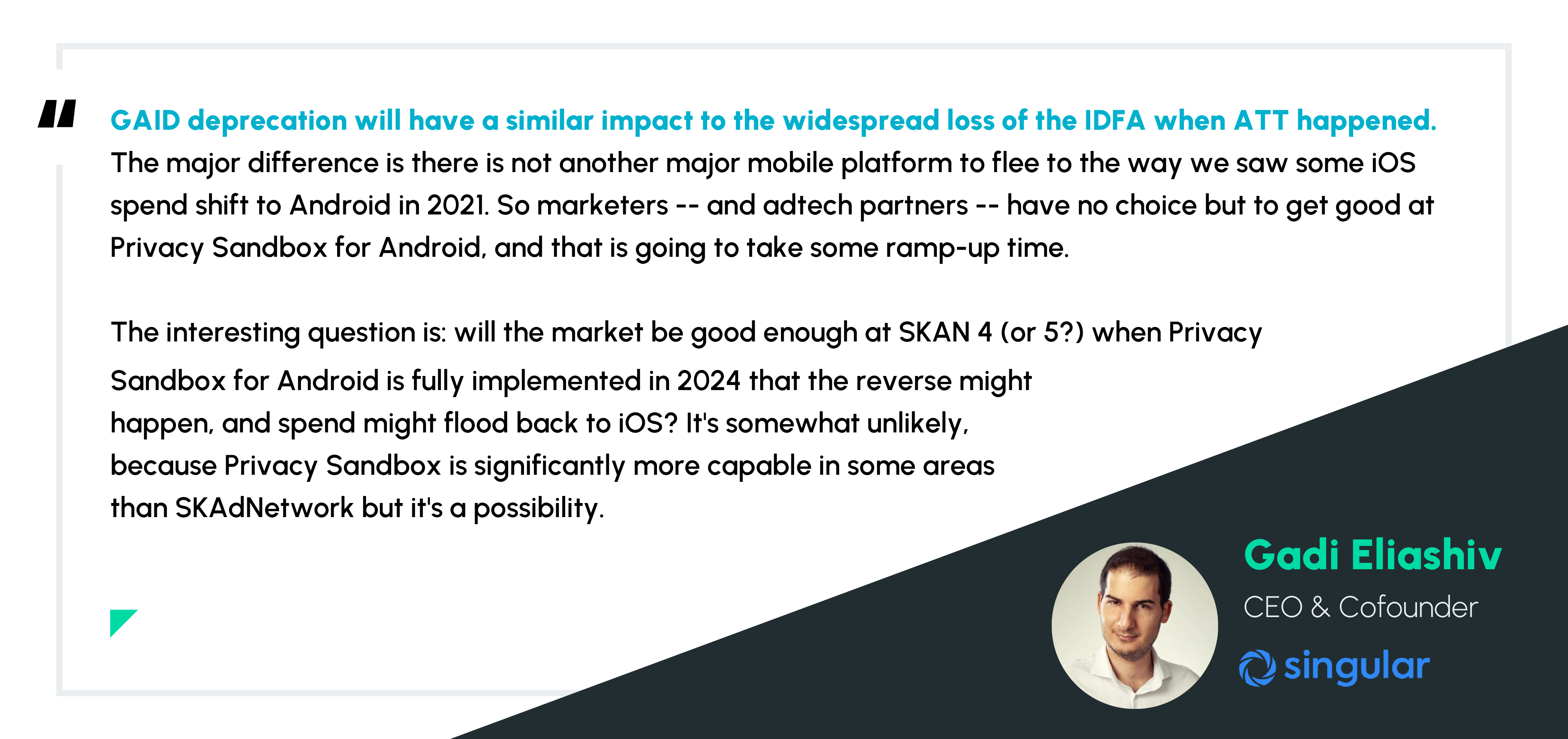
Android has firmly established itself as the largest mobile operating system globally, with over 50% of the worldwide market share since 2014. This share has steadily increased – reaching 71.8% at the end of 2022. With such vast reach, it’s no surprise that Android has for so long been the preferred platform for mobile marketing campaigns. After all, it’s important to choose a channel that can reach your target audience. And what better choice is there than a mobile operating system with access to such a great chunk of the world’s population?
But having a wide reach is only one of the factors to consider when choosing where to advertise your mobile apps. It is most certainly not the only reason mobile marketers choose to advertise on Android.
The struggles mobile marketers experienced with the onset of Apple’s iOS 14.5 meant Android’s share of the advertising budget received a boost. Constant updates and regular addition of new features to the Android operating system also helped attract more spend. Their careful steps and open conversations with the industry mean advertisers are unlikely to shift away from the platform, despite big change looming with the full release of Android’s Privacy Sandbox.
Quick Links
- Introduction of the Google Advertising ID
- Launch of New Ad Formats
- Shift to Android Post-iOS 14.5
- Release of Android 12
- The Newest Update: Google’s Privacy Sandbox for Android
- Industry Thought Leaders on the Privacy Sandbox for Android
- Conclusion
Introduction of the Google Advertising ID
It all started when the Google Advertising ID (GAID), often used interchangeably with the Android Advertising ID (AAID), was introduced in 2013 as part of Google Play Services Version 4.0. GAID is a unique identifier assigned to each Android device that can be used by advertisers to deliver targeted ads without revealing the user’s identity or personal information. Before this, advertisers had to rely on identifiers such as cookies and IP addresses to target a specific user. These methods were often not very accurate or reliable and raised significant privacy concerns for users.
In response to these concerns, Google introduced the Google Advertising ID as a more privacy-friendly way for advertisers to track users and deliver targeted ads. The introduction of GAID gave advertisers additional options besides using identifiers such as the Android ID, which was never designed for advertising purposes. Users no longer had to worry about their personal information being accessed by advertisers. GAID’s accuracy and consistency across multiple devices also benefitted advertisers as it is linked to a user’s Google account. This meant advertisers could track their activity across apps and devices – gaining a comprehensive understanding of their users’ interests and preferences. This enabled them to deliver personalized ads relevant to the user’s needs, and ultimately deliver higher engagement rates and better ROI for their advertising campaigns.
Launch of New Ad Formats
In the years after the introduction of GAID, Android continued to release more innovative solutions to make advertising a more seamless experience for both the advertiser and the user.
One of Android’s most appealing attributes is that it is an open-source platform. It allows developers to modify the operating system as they deem fit. Due to the nature of the system, they have been able to foster a large and active developer community who are constantly testing out new technologies. This explains why many new features launch on Android ahead of its competitors. Among these features are new ad formats. Two ad formats that first found their way into the Android operating system were trial run ads and interactive interstitial ads.
Trial Run Ads, introduced in 2015, are a type of app ad format that allows users to play a game for up to 60 seconds by streaming content from the app before downloading it. This immersive demo increases the likelihood that users who install the app will be interested in playing the game. Developers can then attract better-qualified users who have chosen the game based on what they have already experienced.
When Trial Run Ads were launched, a beta for interactive interstitial ads was also included. Interactive Interstitial ads are HTML5 ads that offer a customized user experience tailored to each advertiser’s app. They allow advertisers to use HTML5 instead of standard templates, pull in data dynamically, and offer a custom experience with unlimited customization. Unlike the previous format, this is not limited to gaming apps, and it offers unique testing and optimization capabilities. This format has steadily evolved over the years and is like the ‘playable ads’ format around today.
New ad formats are a great way to reach new audiences or better target existing audiences. It also helps advertisers differentiate themselves from their competitors – allowing them to stand out in a crowded mobile marketplace. With new technologies being developed each day, it comes as no shock that advertisers are utilizing Android’s flexibility to embrace innovation.
Shift to Android Post-iOS 14.5
In April 2021, Apple released iOS 14.5 to introduce new privacy features that give users more control over the way their data is collected and used by apps. One of the key features of the update is the App Tracking Transparency (ATT) framework, which requires app developers to obtain explicit user consent before tracking their activity across other companies’ apps and websites for advertising purposes. This means that when a user opens an app that is set up to track their activity, they will first see a prompt asking for permission to track it. Users can then choose to allow or deny tracking on an app-by-app basis.
This update caused a massive disturbance to the entire mobile marketing industry. For months – even before its launch – advertisers who heavily relied on user-level data had to come up with a solution to continue to deliver ads to the right users, as well as retain the same level of performance as before.
While experimental solutions were being rolled out by advertisers to try and find ways to make things work, a large chunk of advertising budgets was shifted to the more reliable platform – Android.
Just two weeks after the release of iOS 14.5, several marketers were already seeing an increase in ad spend of between 8% and 21% on Android. Ad revenue on iOS ads dropped by as much as 9%. The struggle to find the perfect solution for the changes on iOS became even more apparent as total gaming app installs rose by 8% on Android in 2022 while it declined by 5% on iOS in the same period. CPI’s also significantly increased for iOS while Android remained steady.
While it was not necessarily a change in Android that caused this, it is precisely because of the operating system’s stability that advertisers saw it as the more reliable option at the time, leading to the shift in ad spend.
Release of Android 12
However, everyone knew that it was only a matter of time before Android changed to accommodate growing user privacy concerns. While Apple released ATT in 2021, it came to light that Google had already been working on a privacy-centric initiative two years prior (in 2019) when the Google Privacy Sandbox was revealed. Similar to the way in which Google addressed privacy concerns in 2013 – with the introduction of GAID – they once again attempted to come up with a solution that not only safeguarded user privacy but also ensured that content remained available on the internet at no additional cost.
With their desire to develop new web standards while consistently seeking industry feedback, it was a drawn-out journey. However, advertisers finally got a glimpse of the extent of the initiative with the release of Android 12.
For users, the most apparent change comes in the form of the Privacy Dashboard: a simple and clear timeline view that gives users more visibility and control over how apps are accessing their data. In addition to seeing this information more easily, it also allows users to instantly change the permissions the app has access to.
Around the same time as the release of Android 12, Google introduced a new section on Google Play called the Data Safety section. This new policy requires developers to provide information about the data being collected and used by their apps on their app’s Play Store page. This includes information about the types of data collected, how the data is used, and whether it is shared with third parties.
While some of these changes may have been expected after the initial announcement of the Privacy Sandbox, the biggest difference on Android 12 for advertisers is how GAID is managed. From the start – when GAID was first launched – users were able to opt out of targeted advertising. However, GAID could still be used for limited purposes outside of outright advertising, such as attribution, analytics, and fraud prevention. Anyone could also choose to reset their GAID at any time, effectively erasing any personal data gathered about them to start afresh. With Android 12 users have more options. On top of being able to reset GAID, users can now delete it entirely. Once a user opts out, GAID is completely wiped out and changed into a string of zeros.
With all that being said, Google is making an effort to ensure that alternatives to GAID are in place. Unlike with ATT, none of these changes happen instantly, or without the feedback of industry stakeholders, so advertisers will still have a reliable platform to advertise on.
The Newest Update: Google’s Privacy Sandbox for Android
After the sneak peek of Android 12, the long-awaited beta release of Google’s Privacy Sandbox arrived earlier this year. But what exactly is the Privacy Sandbox and why is it shaking up the industry once again?
According to the Privacy Sandbox website, the goal of this initiative is to balance user privacy with the needs of businesses and developers by reducing cross-site and cross-app tracking, while still keeping online content free for everyone.
While some might say that Google’s Privacy Sandbox is comparable to Apple’s App Tracking Transparency, they are not. They are two wildly different approaches to addressing the privacy concerns around online tracking.
ATT requires app developers to obtain user consent through a pop-up message before tracking their data across apps and websites owned by other companies for advertising purposes. Google’s Privacy Sandbox provides privacy-preserving APIs that enable personalized advertising without revealing individual user data.
With the upcoming deprecation of GAID, the APIs are designed to help advertisers target relevant ads to groups of users with similar interests, without revealing individual user data.
There are three main APIs that are part of the Privacy Sandbox for Android:
- Android Topics API – a privacy-preserving API that enables ad networks to find users based on cross-app interests.
- FLEDGE (now called the Protected Audience API) – a privacy-centric audience management solution for remarketing and other instances where custom audiences are needed.
- Attribution Reporting API – a tool providing attribution capabilities and reporting after the deprecation of GAID.
While ATT practically eliminates personalized advertising the moment a user chooses to opt out of it – without resorting to more obscure methods, the Privacy Sandbox ensures that this is still possible, even without GAID.
However, Google acknowledges that these changes pose new limitations to advertising – particularly in the areas of attribution and targeting. Even so, Google continues to develop new frameworks and APIs to help maintain personalized advertising while upholding user privacy. Consequently, for reliable mobile advertising, Android continues to be the preferred option.
Industry Thought Leaders on the Privacy Sandbox for Android
To gain more insight into what the future of the Privacy Sandbox holds, we have brought together top industry experts from major Mobile Measurement Platforms (MMPs) such as AppsFlyer, Branch, Kochava, Singular, and Tenjin to share their perspectives.



Conclusion
As technology continues to evolve in unpredictable ways, the future of mobile advertising remains uncertain. Despite this, it’s clear that the industry must continue to move forward and adapt to stay relevant.
While the future may hold unexpected changes, it’s almost certain that Android’s market share will remain strong. Additionally, Google is taking a thoughtful and collaborative approach to implementing privacy changes – working closely with industry stakeholders such as app developers, ad networks, and mobile measurement partners – to ensure that the best solution is reached for all parties involved, not just the end users. And thanks to its extensive reach, innovative features, and flexibility, you can rely on Android to be a top choice for mobile marketers.
Interested in exploring a new ad campaign for your app on Android? Send us a message here.